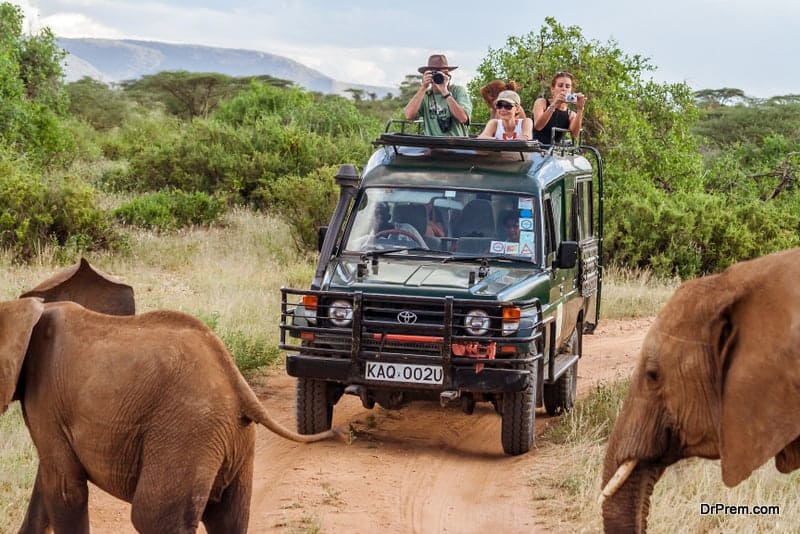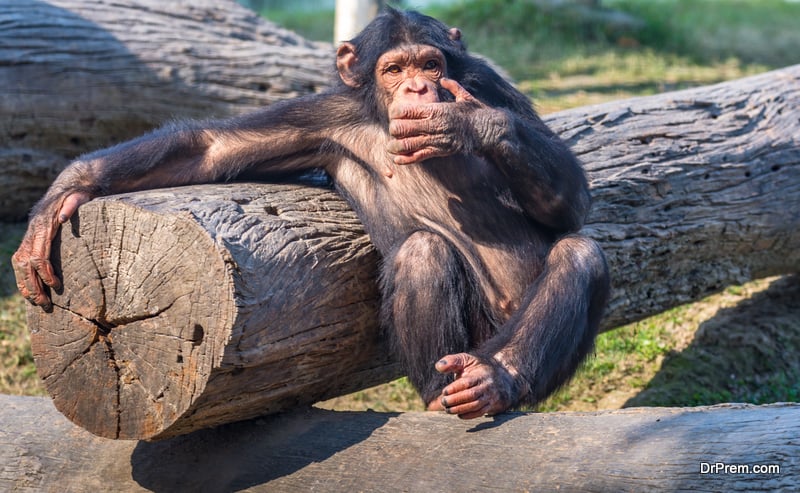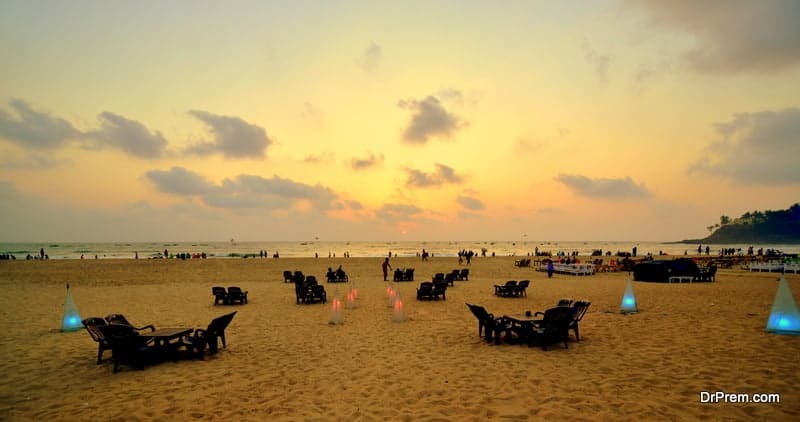Wildlife tourism is not a recent activity that had won popularity among adventure loving tourists. Those with a strong penchant for wild life and its natural habitat had answered the irresistible call of the wild down the ages. In the past, the gun took precedence over camera and men went on foot, elephant and horse backs in search of big games.
The perils were astronomical. Sometimes these daring adventure trips resulted in death of the hunter. If luck stays on his side, he returned with his trophy, the carcass of a lion or a tiger shot by him and carried by his faithful followers. The world watched with startled silence the courage and hunting prowess displayed by him with pride and an air of triumph.
In this guide, you will read about:
Complete Guide to Wildlife Tourism by Dr Prem – Definition, History, Essential features and drivers, Top Destinations and Budget Packages
-
What is wild life tourism?
-
History of wild life tourism
-
Why wild life tourism matters?
-
Is wildlife tourism for you?
-
Essential components of wild life tourism
-
Key drivers of wild life tourism
-
How to get more information on wild life tourism
-
Importance of planning in wildlife tourism
-
Preparations for wildlife tourism
-
Travel and tourism arrangement in wildlife tourism
-
Best practices to be implemented in wild life tourism
-
Precaution and prevention tips in wildlife tourism
-
Countries promoting wild life tourism
-
Nepal
-
Malaysia
-
Thailand
-
India
-
Kenya
-
South Africa
-
Brazil
-
Wildlife destinations for greatest experience on the planet
-
Uganda
-
Vancouver
-
Galapagos Islands
-
The Arctic
-
Borneo
-
Sipadan
-
Super enjoyable safari destinations from around the world
-
Kenya – Masai Mara National Reserve
-
South Africa – Kruger National Park
-
Botswana – Chobe National Park
-
Uganda – Bwindi Impenetrable Forest Reserve
-
Namibia – Etosha National Park
-
Tanzania – Serengeti National Park
-
Zimbabwe – Hwange National Park
-
Wildlife tourism near Congo River
-
National parks
-
Nouabale-Ndoki National Park
-
Dzanga-Ndoki National Park
-
Bird’s Paradise
-
A guide to finding budget wildlife holidays
-
Steps to planning budget wildlife holidays
-
Destination selection
-
Package deals or DIY holidays?
-
Accommodation, when to go and other traveling issues
-
Top budget wildlife holidays for a lifetime experience
-
Cheap safari holidays in South Africa
-
Masai Mara Safari, Kenya
-
Gorilla Safari, Uganda
-
Rhino tracking and Nile cruise, Uganda
-
Serengeti and Ngorongoro crater, Tanzania
-
Johannesburg and Kruger National Park
-
Budget wildlife holidays from around the world
-
Kayak expedition in San Juan
-
Explore turquoise waters of Maldives
-
Participate in turtle conservation, Guatemala
-
Volunteering wildlife rescue, Costa Rica
What is wild life tourism?
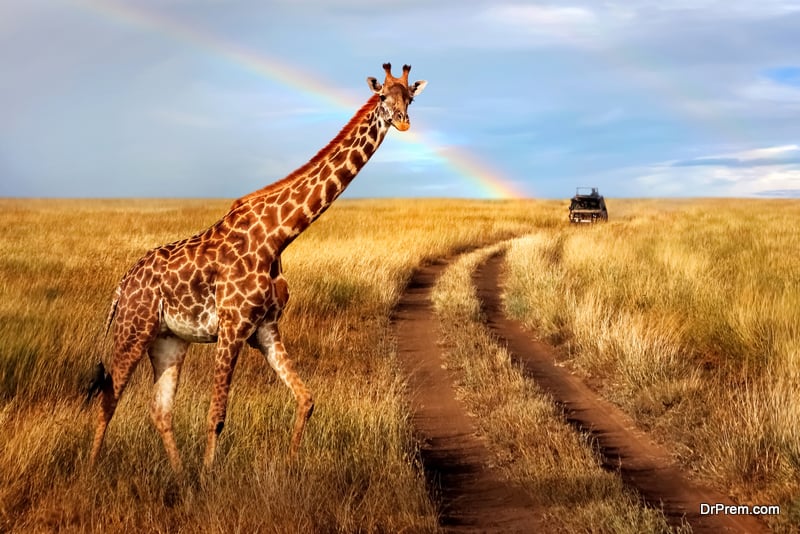
Wild life tourism is a great way to be as close to nature as possible amid an amazing mix of flora and fauna. It is a niche tourism whose popularity is immense. It is an eco-friendly venture having huge economic potential. The tourist is exposed to the animal world in the background of nature. He learns about the animal group behavior, their social structure, communication patterns, social code of discipline, and their mode of interaction and interpretation of the same. A keen observation of animals reacting in a specific way to a given environment draws loads of fun and thrill.
Wild life tourism has a long history behind its evolution. It all started off following the trail of big game. Hunting wild life was the chief motive driven by commercial schemes as well as making a specific settlement free from the attacks of wild lions and tigers and herds of rhinos and elephants who had become a potential menace to the cultivated crops.
The coats, fur, tusks and horns fetched handsome prices, and as an added bonus the hunter makes a name for himself winning the well wishes of the natives rescued from the assault of wild life. Sometimes the tracking involved hundreds of kilometers on foot or horseback before the hunter confronted the animal stalking behind a bush waiting for the kill.
Even today wild life sightings involve covering large areas before you meet a herd or pride. It is packed with nail biting suspense and sometimes danger lurks when you stumble upon a pride of lion feeding on a zebra carcass under the shade of an African baobab tree. How would you feel to have a charging isolated bull elephant in front of you in the African savannas? How would you react viewing a growling ten foot tall grizzly bear in an attempt to protect its cub in the Yellowstone Park in the US -Canadian border?
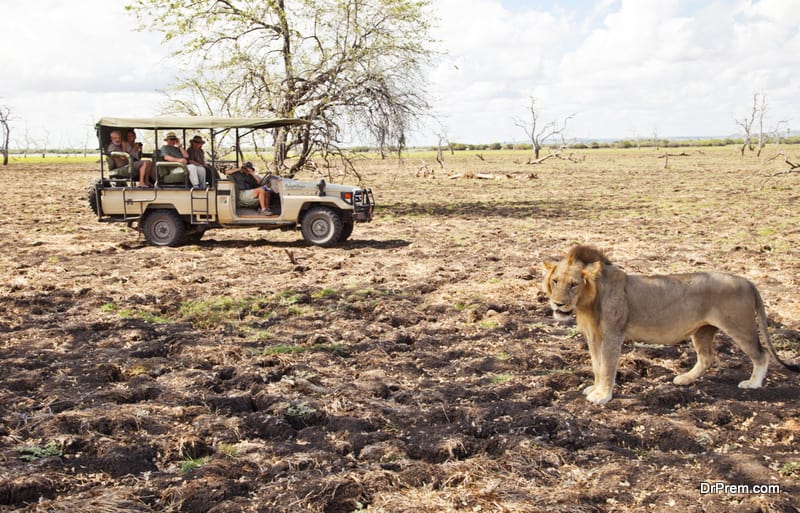
It is all daring adventure and you feel the worth of every dime spent. However, the camera has replaced the gun. No one hunts today. The wild life conservation laws are operative to see the animals and their natural habitats do not get threatened. The travel is done over long distances in land rovers, balloons, steamers and aircrafts.
There are expert guides to feed you on every minute detail on wild life and the jungle. They are an authority on the subject of wild life having years of practical field experience. In fact, they have an ear to nature and can sniff odors, hear sounds and see the trails with telescoping precision, which you fail to realize. They do carry guns in case required against an attack.
Wild life tourism has expert guides tour package arrangements crafted by tour operators. Your itinerary is lodge based and sometimes camp based. You start off in a safari enjoying the landscapes, thick growth of forests and tall grass land on your way watching herds of gnus and zebra crossing over streams filled with hungry crocks, pods of basking hippos, herds of wild buffalos grazing and the elephants on a group feeding spree. If luck stays on your side, you watch the thrilling spectacle of a bolting cheetah bring down a Thomson’s gazelle or a pride of lions hanging on to a cape buffalo.
It is all thrill and suspense before you reach your lodge or camp where good food, drink and hospitality are waiting to entertain you. As an added bonus, you may relish the legend of a local man-eating lion that had once turned the region into a slaughterhouse! Wild life tourism is an ever expanding billion-dollar industry.
Africa with her immense wealth of wild life and forest cover has been traditionally a big inspiration in wild life tourism with world famous national parks like Masaimara, Ngorongoro crater and Kruger National Park drawing tourists in flocks . Other notable wild life tourism destinations are Australia, Canada, US, South America, India, Malaysia and Nepal.
Wild life tourism is basically a form of ecotourism where ecological balance is retained. The tourist enjoys his trip within the safety of the tour vehicle. An efficient tour guide accompanies you and your group. Everything happens with thrill and adventure without any harm done to wild life and its natural habitat.
History of wild life tourism
Hunting – the adventurous aspect of wildlife tourism

India had been famous for its dense forests and a huge wild life population constituting fierce carnivores, wild herbivores and a variety of land, arboreal and aquatic reptiles, acrobatic primates and a host of colorful birds. The forests came alive with their growls, grunts, hisses and chirps. It was a favorite past time for Maharajahs and Zamindars to go on a hunting spree. This was wild adventure and a mark of courage. The maharajas of Princely states scattered across the Indian subcontinent like Rajasthan, Mysore, Nepal, Gwalior and Assam went out into the wilds with an army of followers with much fan fare. There were beaters who herded the wild animal round the corner so that the maharaja can accomplish his hunt at his leisure from the ‘howdah’ , the regal seat mounted on elephant back or the ‘ machan, which is a makeshift sitting arrangement perched high up on the tree . The hunter had a vantage point for getting a perfect view to a kill.
These legendary wild life safaris are primarily driven by a fierce chauvinism; an intense esteem of one’s own physical ability and male courage. The expedition sometimes lasted for months. The queen and the women folk waited for the king to return from his hunting trip with pomp and grandiose.
The result of the trip generally culminated in an awe-inspiring display in the royal palace with the muzzles of elephants, wild gaurs, sambars, tigers and leopards, the victims of the Rajah’s gunshot. The focus was more on hunting rather than observing wild life behavior in their habitat. Arrangement for the stock of food, water, tents and management of a huge group had to be planned as it is done today. Since restriction on hunting did not exist, the touring team gathered food by hunting down sambar, deer and fowl. The expeditions were basically filled with thrill and kill.
These legendary wild life safaris are primarily driven by a fierce chauvinism; an intense esteem of one’s own physical ability and male courage. The expedition sometimes lasted for months. The queen and the women folk waited for the king to return from his hunting trip with pomp and grandiose.
The result of the trip generally culminated in an awe-inspiring display in the royal palace with the muzzles of elephants, wild gaurs, sambars, tigers and leopards, the victims of the Rajah’s gunshot. The focus was more on hunting rather than observing wild life behavior in their habitat. Arrangement for the stock of food, water, tents and management of a huge group had to be planned as it is done today. Since restriction on hunting did not exist, the touring team gathered food by hunting down sambar, deer and fowl. The expeditions were basically filled with thrill and kill.
Wildlife expeditions and safaris in Africa
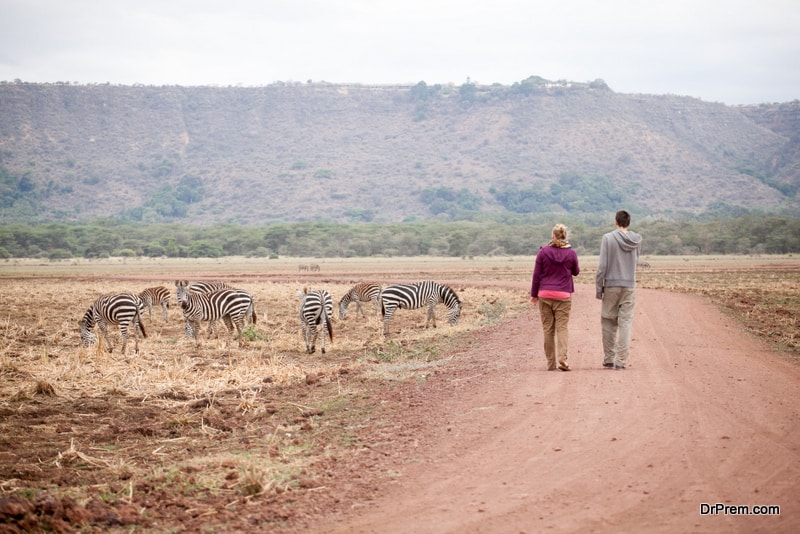
If we look into the history of African wild life expeditions, we will be startled at the sheer scale of these adventure trips and the enormous perils lying in wait on the way. Livingstone and Stanley are awe inspiring names in African safaris. Armed with provisions, guns and ammunitions, local African porters, doctor, grit, courage, a fiery passion for adventure and finally an intense desire to make a name, they have traversed across the entire east- west of the Dark Continent.

The initial size of the group drastically reduced upon the completion of expeditions. Deadly diseases like yellow fever, malaria and bilharzias claimed lives. Some became victims to wild animal attacks while others simply perished under stress and strain of the expeditions! Nevertheless, despite the loss of lives and inhuman pain and hazards, the dangerous wild life safaris continued to lure man. The call of the wild was too tempting to resist. The wild life and the jungle had always enchanted man.
They felt a strong desire to undertake wild life expeditions. The pull cuts across the races and civilizations. Tracking down lions in the wild and hunting them with spears was traditionally very popular, and considered a chivalrous and daring act among the Moran warriors of the African Masai tribes and among Egyptians. The lure of the wild and a passionate yearning to meet the beast was more powerful to offset the danger that goes with it. Wild life expeditions were certainly made by the Romans in the African and Eurasians wild building up a formidable inventory of wild beasts for gladiatorial combats.
Why wild life tourism matters?
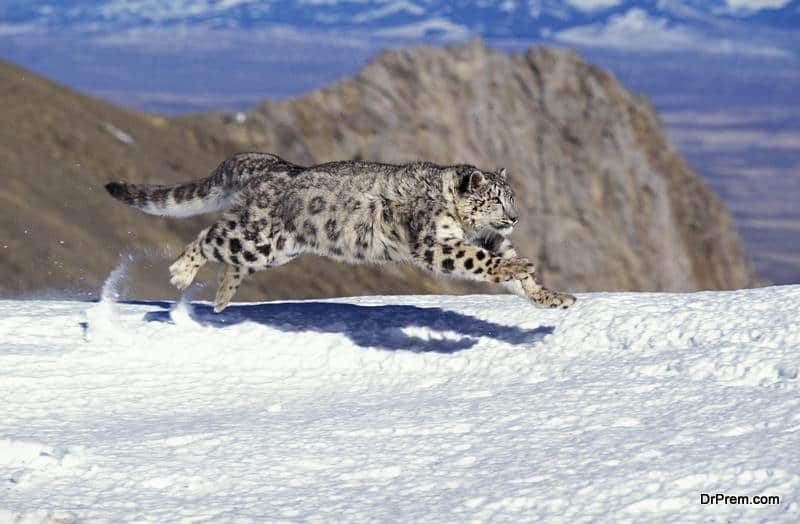
Wild life tourism is watching the wild animals in action in their habitats. The world that we live in is a wonderful place, and it is some cosmic design that has set everything in equilibrium. It is in fact a mighty piece of architecture where nothing works in isolation. It is a big place inhabited by humans, plants, wildlife, domestic animals, microorganism, birds and the aquatic life.
There exists the inanimate world as well comprising of rock, sand, water, air and mud. All the objects in this world are in constant interaction with each other. Even these interactions follow a definite pattern. A disruption in the pattern leads to destructive phenomena like global warming, wars, outbreak of diseases, famine, flood, quakes and tsunamis.
Some of these are within human control while some are beyond. Animal world is a big part of the earth’s constituents. Neither can we ignore them nor can we neglect, and the question of exploitation like poaching amounts to a criminal act. Our interaction, attitude and concern towards the wild life help maintain the ecological balance.
It keeps the food chain pyramid in a stable equilibrium ultimately ensuring global harmony. We need to realize that we are not the only residents of the planet earth. Our neighbor, the wild life has a greater share of space which we must not deprive them of. We need to make wild life expeditions and observe them from close quarters. We need to feel their pulse and understand all they try to convey.
The social behavior of a pack of wild dogs is an interesting spectacle to watch. How the pack chases and catches up with a prey much bigger in size and stronger is a scene worth loads of appreciation. The grit and concerted effort of the pack eventually brings down the prey that devours it in a feeding frenzy until only fragments of bones and flesh are left.
There may be a one- or two-day’s recess after which these animals look for the next kill. Sometimes they win and sometimes they lose, but the battle for existence goes on bringing live a documentary on struggle for survival on your jungle safari. That a world so full with action, excitement, motion and group efforts exist cannot actually be realized unless the tourist ventures out on a wild life expedition, and is exposed to this ruthless and yet a beautiful world dominated by plants and animals.
From the ecological standpoint, the sustenance of the flora and fauna can only be ensured if we extend our efforts to combat the elements like diseases, habitat loss and mindless poaching that threatens their existence. For launching these efforts generation of funds is imperative, and every dime a wild life tourist spends as entry fee to a sanctuary or a reserve forest goes to the wild life welfare fund.
To wish wild life population a long and cheerful health, wild life tourism needs to be encouraged. The quality of expeditions should be enhanced, and an all-round awareness should be spread to keep Mother Nature and its wild inhabitants in a healthy state.
Wild life tourism improves the economic health of all the components included in tourism. It generates employment for the local, makes the local business of hotels, eateries, transports and provision shops flourish. These components are the life blood of wildlife tourism, and their smooth survival will help wild life tourism run smoothly.
It is an interdependent cycle, wild life tourism being on the focal point. The tourist is on one side and the service providers on the other. Wild life tourism brings the tourists and service providers close to each other. One derives benefit from the presence of the other with wild life tourism being the central fulcrum.
Is wildlife tourism for you?

Wild life tourism has an immense appeal worldwide and is an instant hit. Neither do you need to cultivate a specific taste for wild life tourism nor do you need to acquire a specific sense of appreciation before you decide its time you need a getaway amid wilderness. Our love for animals is a very basic emotional vent. This affinity towards wild life has been in our blood from our infant age.
Possibly, all of us had been to the zoo with our parents, and it was a big pleasure for us to be there. Facing tigers, lions, elephants and rhinos in their enclosure had a special kind of thrill for us. We waited before their cages for hours watching every movement from feeding and basking in the sun to pacing up and down the enclosure. In fact, wild life had always fascinated us from childhood and it is a plain reality.

It inspired us to keep pet dogs, cats and birds, and spend hours of quality time interacting with them. The latent desire is always in us to have the company of animals. If the animals are wild and fierce, the desire multiplied, and a combination of thrill and joy added a new dimension to our cravings. Giving a highway to the flow of our basic childhood desires cannot be better than a full-fledged experience of a thrill filled wild life tourism.
Wild life tourism has become wonderfully customized. The travel agencies equipped with the latest updates ensure that they use them to the best of advantage to make your wildlife tourism experience an amazing one. The perils and hazards that a traveler encountered on a wild life safari in the past no longer exist. This had been made possible because of the hard exercise, efficiency and foresightedness with which the services of the travel agencies are designed to combat the hazards of wild life tourism.
For example, the vast expanse of grasslands with occasional overgrowth of shrubbery keeps you in anticipation of meeting a large carnivore. From within the safety of your land rover, you desperately wish so much to sight a dangerous carnivore instead of a harmless impala. Your excitement mounts, adrenaline pumps faster and your eyes are narrowed down in expectation. The thrill is not overbearing, and you feel your expedition dollars did not go waste. Every dime you spent is paid back to you by several times when you have a rare glimpse of a python crushing the muzzle of a Langur in a quick snap!
Amid a wild setting, the lodges and jungle camps are cozy answering the needs of a tourist in a satisfying way. The comforts that you have in a city thousands of kilometers away are brought in your little camp where can have a peaceful sleep overnight and wake up the next morning in order to join the adventure trip.
If you have the longing for the call of the jungle, wild life tourism is the ideal escapade to have your dreams realized.
Essential components of wild life tourism
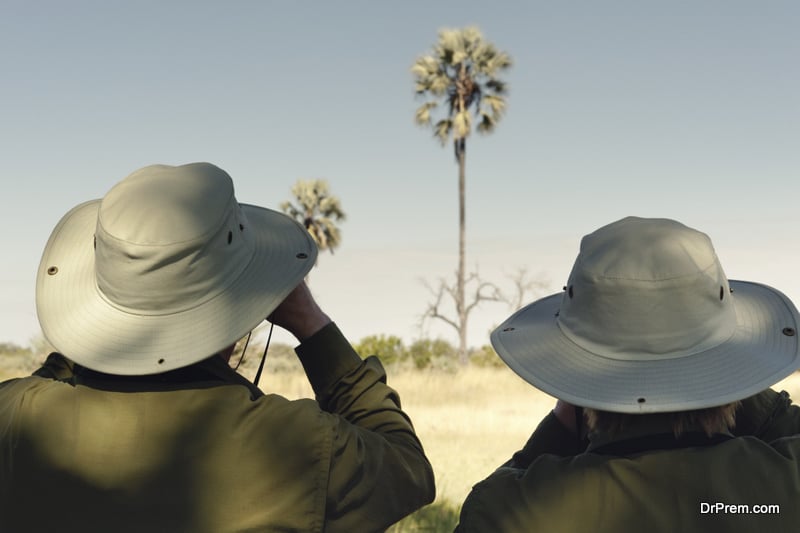
The success of wildlife tourism rests on the basic platform of the resources available, the tourist and the locals who live in proximity of the wild life country. The basic components mentioned should go compatible.
The tourist and the host should be complementary to each other, that is, they should fulfill each other’s requirement and strike a fine equilibrium that they are held in peaceful coexistence with each looking forward to the presence of the other against a backdrop of the wildlife country. The interaction between the local host and the tourist guest and the flow of material and attitude-based elements between them should sustain wildlife tourism and further the interests of tourists and the local environment as well.
Expedition into a wild life country means a certain level of contact is established between the locals and tourists. This contact should breed constructive outcome to promote wild life tourism in the region. There must not be any notion brewing within the sentiments of the local tribes of environmental pollution brought in with the arrival of outsiders.
Nor they must feel a threat of encroachment by tourists for achieving their exploits. Specifically, the tribes are very simple and sensitive. They look upon strangers with suspicion. Their sentiments must not be hurt as to invite enmity that will damage the spirit of wild life tourism. Their customs however bizarre they might look should be respected.
Wild life tourism industry should be designed to generate employment for the local and should enhance the economy of the region for its sustenance. The host must look forward to embrace wildlife tourism with open arms. They should be encouraged to contribute towards the up gradation of wild life tourism.
The importance of resources as a vital component to keep wild life tourism going cannot be denied. Out of the resource component the position of flora and fauna is at the apex. The quality, size and the variety of plant and animal population decides the tourist appeal of a wild life country.
All round effort is to be made to enhance this immense natural wealth by initiating movement against poaching, lumbering and disturbing the ecosystem. It is a complex chain involving the food pyramid and survival of the components of the pyramid-plants, herbivore and carnivore feeding cycle.
A detailed survey should be continuously carried out to figure out the quantity of grass and plant matter available per sq km to sustain the herbivore population. The size of herbivore population available to feed the carnivores is the prime attraction. The adequacy and quality of food obtainable are important. Animal migration aspect has to be factored in as well. Environment experts and ecologists should walk in with concrete solutions so that the region doesn’t turn barren devoid of plant and animal life.
Next important resource base is the infrastructural set up. Accommodations and medical facilities with world standard service are essential. The availability and reliability of transport are equally important to support the tourism.
Basically, there should be an all-round awareness alive in the air and the people must come forward whole heartedly to extend their resources to the tourist so that his expedition turns into an impressive experience. On the other end, the flow of money from the customer should be reasonable.
The tourist mass constitutes one of the most important component as it is them who will visit the wild life country. More tourists would mean more inflow of dollars. The money flowing from the tourist will sustain wild life tourism business promoting the economy of the region. The welfare measures should be supported by the money generated leading to up gradation of the infrastructure of the region.All the components mentioned form the backbone of wild life tourism which ultimately decides the future of a particular destination.
Key drivers of wild life tourism
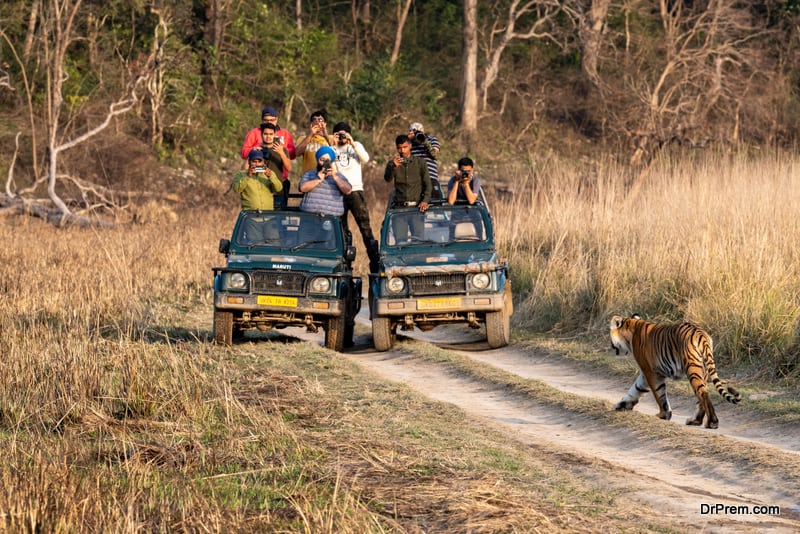
Diversity and the huge mass of plant and animal specimens are major key factors that enhance the tourist appeal of a wild life country. Tourists visiting wild life destinations look for loads of adventurous thrill, fun and excitement. It is the clash of tooth and claws against horns, hooves and antlers, contact between tusks and canines, dramatic predator prey chases, successful hunts and narrow escapes that turn the tourists on.
The actions involved in a carnivore- herbivore confrontation or when a bull, rhino or a male tusker goes for a head on charge against your land rover make you feel that panic; adrenaline pours into your system and yet you love to pay to make such situations happen.
You will not love to wait a long day or a sleepless night for a sickly lion to limp to a water hole for its need. You will love to see your animal healthy, teeming in population against a lush background. The quantity, quality and an assortment of different species of animals are exactly what will drive you on to make repeat visits to a wild life destination.
It becomes your dream destination. Words of appreciation from you and other tourists like you spread like wildfire arousing the interest of more tourists. More visits take place and the wild life tourism business flourishes with a roaring pitch. But dramatic situations rarely happen. You may expect wild encounters, but you need to be lucky enough to sight six male lions bring down a one-ton cape buffalo.
It is all a game of probability and chance factor playing in your favor and do not be shocked if you come across such a spectacle. It is just the mechanism of natural selection working its way. Attitude towards wild life tourism is of prime importance. Role played by the government-backed tourism department, local inhabitants and eventually the tourists on expedition are key drivers as well. Their stand goes a long way in bringing a wild life tour destination under the lime light.
Conservation of the flora and fauna is imperative. Periodical appraisal and assurance are launched by the forest department to see if ecological stability and harmony rules. The accommodation and transport are key drivers very much. Without a proper place to stay, a cozy bed to rest and good food to eat you do not draw sufficient vigor to keep you charged for your trip into the wild.
Without a good and sturdy transport, you cannot proceed even a hundred yards around. You need a good driver, enough fuel and an experienced forest guide to explore and enjoy the wild world outside your cottage. A ruthless and yet a beautiful world where the fittest survives, the doe demonstrates her motherly affection towards kid and the tailor bird sings busily focused on stitching two leaves.
It is ultimately the flow of money that keeps the spirit of wild life tourism throbbing and that is sourced from the tourist. To keep the source pumping in money into the system, the tourist needs to be delivered quality service. His experience of the wild life expedition should worth the money he spends. All the service providers should get their fair share, and the flow should not get blocked at some corner where someone tries to get an unfair cut depriving others. This keeps all operating in the wild life tourism chain happy, and the system operates on well-oiled gears.
Drivers to wildlife tourism should run vigorously with perfect coordination. Attitude towards wild life tourism should be positive with required emphasis on financial support or else the spirit of wild life tourism would go dry and forests would turn barren.
How to get more information on wild life tourism

Wild life tourism has grown in popularity for quite some time. Information on the same can be acquired from a number of sources. The easiest approach will be to browse on the internet search engine. There are several websites exclusively dedicated to specific wild life game reserves and sanctuaries.
They feed you with sufficient information ranging from the mode of access, accommodation arrangement and tariffs, availability of transport, the best time of the year for a visit, special precautions if any and finally the diversity of plant and animals found in the region.
Despite the relevant information about the renowned sanctuaries and reserve forests, the wild world still houses virgin patches untouched by man. Information on these undiscovered regions is yet to come to public exposure. Someday we will come to know of their existence and may be an entirely new species previously not known to the world will be exposed.
Wild life enthusiasts all over the world have formed associations. They hold periodical forums and seminars on wild life tourism and all the related information. These animal lovers are active on the net. Information, queries and answers flood the online forums and could be a feedback base for setting out for an expedition to the animal kingdom.
Tourism departments of different countries are storehouses of data pertaining to wild life tourism. These departments issue booklet, guide maps and literature relating to wild life. The public awareness and responsibility towards the animals and their natural habitat are communicated to the world at large by these circulating literatures.
Many information and facts come up, which were previously unknown. For the wild life tourist out on gorilla expedition, he must keep a distance of seven meters at least from the animal and its group to prevent the spread of human disease. Out of the same reason, a tourist is not allowed to urinate once he enters in a gorilla habitat. If the tourist needs to defecate, he has got to do it in a hole, pour in disinfectant and cover it with mud.
Gorillas have a habit of eating night soil; hence the precaution. These facts are startling, but they are important pieces of information which may affect wild life and habitat in an adverse way if precautionary measures are not taken. Wild animals roam in a pollution free environment. They are vulnerable to the toxic waste of civilization carried by human visitors. Lack of information about the ways of the jungle may lead to the extinction of an entire species altogether.
Books on animal behavior offer authentic information, which may affect wild life tourism. The hippos of African rivers could be very dangerous if you go too near their pods on your cruise steamer. These creatures are fiercely territorial and too treacherous to be funny. So when sighting hippos keep a safe distance. They may surprise you with their swiftness despite their huge bulk. These small information are important lack of which could be fatal.
Bodies like national wild life visitor centers, web magazines and wild life programs on television feed the tourist with vital information like which animals and birds are on the verge of extinction and what are the efforts being initiated to check it, distribution of various wild life species across the globe, their density and the condition of their habitat. They also enlighten us with such information like the network of routes along which the migratory birds fly and the season of migration and possibility of sightings by the visiting tourist.
Information on wild life tourism is significant because it affects your expedition to a large extent. It is advised the information to be acquired from such non commercial organizations who do not have the sole objective to expand business. The facts should be authentic and unbiased.
Importance of planning in wildlife tourism

Nothing could be as important as how you plan your wild life expeditions and manage the entire venture according to the drawn up plans. The initial go will be to decide on the destination offering a wild life exposure. The globe is a big enough place accommodating a diverse range of animals and plants in varied climatic conditions. However, preference shifts from tourist to tourist. Some may be inclined towards the arctic wild life while others may get turned on by the African savannas.
A vast grassy landscape covered by moving herds of zebras, gnus, elephants and the stalking pride of lions is all he wants to see, while there may be a tourist who gets enchanted by the unusually strange animals like koalas, moose and emus that dominates an outback down under. The kind of animal you want to watch is important. If you desire to have a thrill packed tiger and lion expedition in one go that is not possible. They stay way apart, and the geographical location of that wild life species is very important as this factor will dictate the planning.
Before physically launching your wild expedition trip, get acquainted with the flora and fauna you are looking for. There is enough illustrated literature available on the internet and in books on animal and plant kingdom. You get to know the country where the species you are looking for is found. The type of habitat, the best season to visit, other groups of animals that are found in the same habitat, the typical behavior of a specific animal in group and in isolation, potential threats from the animal if any are all fragments of information that will prepare you mentally before you pack your camera and luggage and board your flight. You will appreciate the importance of this information beforehand once you land on your dream wild life destination.
The duration of stay in a wild life country is an important factor, which has a lot of bearing on your trip. The tour expense is proportionate to the number of days spent. If you are on a fairly long trip, say about fifteen days, probably the number of photography shots taken by you will be large. In that case you must plan to take a DSLR or digital camera which will help you a lot.
If you are budget conscious and still look for a long and wide exposure to wild life, you will face a high transportation cost due to frequent safari trips covering long distances. You will probably get a bigger animal coverage, and your vehicle rental expense will shoot in which case you will probably have to look for moderate hotels and average food so that your overall expense graph stays within control.
Since in wild life safaris your trip coverage is very wide and wild with no medical facilities nearby, your travel plan must include carrying basic medicines. Your clothes must be light and yet sturdy to bear the stress and strain of wild life expedition.
In your plan coverage, you need to give some thought and space for a sustained eco-friendly trip. You do have certain responsibilities to discharge. If you are a chain smoker and a heavy drinker, refrain from those habits while on trip. This will put a check on your contribution to the atmospheric pollution of the wild life zone you have planned to visit.
Your plan horizon should encompass the category of accommodation you would like to have. You may prefer city hotels, hire a land rover, do a safari all day and be back by nightfall. You may opt to stay in camps or jungle lodges in between the long duration safaris. You drive and watch wild life throughout the day, park for a night stopover in a shelter, get some sleep, have tea and breakfast next morning and resume your safari.
In wild life tourism, planning for contingencies is always significant. You may get stranded for days in your lodge due to a heavy spell of rain that goes on nonstop. Jungles turn impenetrable traps with fresh rivulets springing up turning the roads to a horrible shape. Such uncertainties and surprises are to be factored in. You may need some extra money to tide over the situation.
To counter the hardships and difficulties that may arise in your wild life expedition, the importance of planning is imperative.
Preparations for wildlife tourism
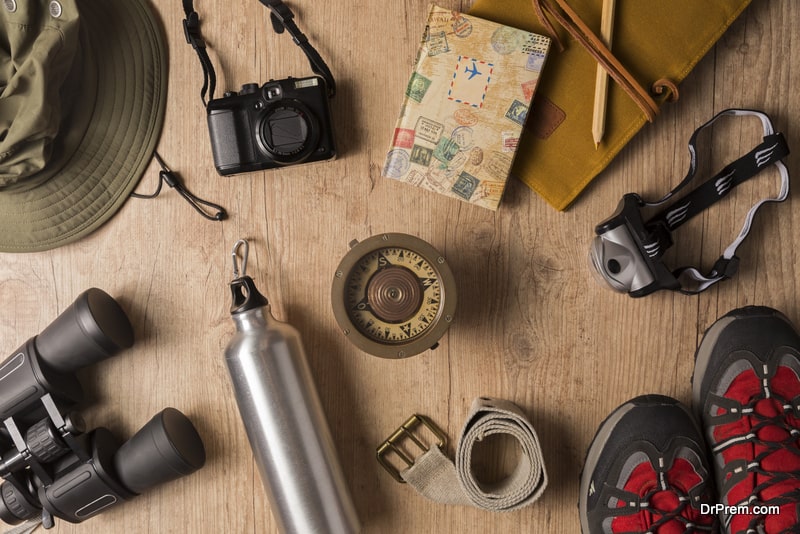
Wild life tourism is loaded with fun, thrill and adventure in the truest sense. One distinct feature that makes it stand apart from other forms of tourism is covering vast areas of bush and thick woods amid an isolated country where the nearest hotel, medical facilities and provision stores might be hundreds of kilometers away. You must ensure before launching for a wildlife trip that you are physically fit. This is most important and could be a deciding factor.
Adequate basic medicines are to be carried to combat common diseases like fever, stomach upsets, dizziness, cold and cough and injuries. When travelling to the paradise of wild life tour, it is wise to have the doctor’s advice whether to take preventive vaccines or not. Mosquitoes and flies are dangerous threats as they are found in plenty.
Drawing parallels, the equatorial rain forests of Malaysia and the wilds of north eastern parts of India are infested with disease bearing mosquitoes. Preparations should be taken regarding carrying enough medicinal protections. Since wild life tourism requires traversing large areas of land with lots of uncertainties waiting on your route, it is best to carry sufficient stock of water and nonperishable dry food.
Knee length leather boots would be ideal in case you run into poisonous insects and snakes. It is good to have a guide map of the local area in case you lose your way in the forest. A magnetic compass would be of help for that matter.
While on a trip to wild life, focus on light colored clothing tough enough to withstand the stress of long trips through the wild. If you are travelling along in an open country like in central African savannas with the sun burning overhead, white clothing is best. On the other hand, in Canadian wilds warm clothing is a must.
Before setting out on a wild life tour, you need to know about what kind of staying arrangement and transport is available. Normally, star hotels are not found in a jungle safari and you may need to camp overnight. If you opt for staying in a camp, make sure it is safe from disease carrying insects. A light hand scarf would be fine to beat the scorching sun.
Fancy and colorful luggage must be avoided. Take something sturdy to bear the strain of wild safaris.Before taking a trip to a wild life country, enquire from your travel agents exactly what animals are to be covered in the program. Taking your camera to a wild life trip is as important as your daily requirement of food and water.
Your camera should have enough zooming capacity. This is important since cape buffalos are one of the most dangerous animal species. Proximity to these creatures may be life threatening. Yet you need to take the snap of the awe-inspiring herd gracefully chewing the cud or sniffing the air to locate a potential threat!
Sufficient batteries and chargers need to be carried, and remember the important piece of information in open wild you may not have any electrical recharging facility, but you need to capture the priceless shots. A movie camera would work wonders on predator, prey chase and hunting scenes!
Travel and tourism arrangement in wildlife tourism
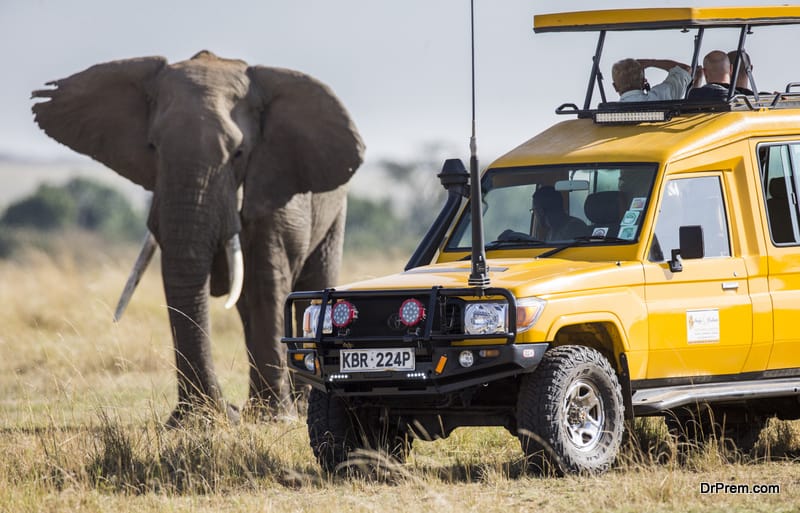
With the wild life tourism gaining momentum, the network of travel agencies has expanded their services far and wide. The forest departments backed with the support of chief conservators have come up to encourage tourists in the wild life zone. However, the stress is always on to sustain wild life tourism without misbalancing our ecosystem.
Therefore, the welfare of the flora and fauna is of prime concern. The various wild life travel agencies and tour operators offer compact wild life tour packages at competitive rates. Their service coverage basically embraces flight booking to and from the wild life destination, management of a large group of tourist with minimum confusion ensuring a hassle free trip.
Liaisoning with the local transport and hotel owners and arranging for sightseeing and accommodation for the tourist form the vital features of these packages. Here, the target is to build a strong and trusted network of service providers. Coordination is based on clarity, efficiency and swiftness so that issues at every stage of the trip is handled very smoothly.
Sometimes the travel agencies have their own chain of accommodations and fleet of transport minimizing the dependence on middlemen. Customer tourist can lodge direct complaint to the tour operator for deficiencies in service received if any. The prime objective is to ensure the customer should enjoy his money’s worth of wildlife experience if not more.
Efficient management of the tourist kitchen, quality and timely delivery of food are important aspects. Here, the tourist may have a reservation as food is a sensitive issue. Tourists may be from both vegetarian and non-vegetarian category. Some tourists may be allergic to a specific type of food. All these important factors are well taken care of. Standby arrangements in case of medical emergency are kept in view and delivered when situation demands.
After dispatching a group into a wild life safari, the progress of the trip is sometimes closely monitored. The communication links are ever busy keeping the base office posted about the developments, wild life sightings and problems encountered if any.
The tour agencies have a host of duties and responsibilities to discharge. The contact with the local inhabitants, the infrastructural set ups and the government regulations should be kept in view in cases where they have a direct impact on wild life tourism.
For example, imposition of a forest tax or hike in the existing tax will directly affect the tourist. All the latest updates flowing from local conditions are taken into account with a special emphasis on the degree of support and attitude of the locals towards wild life tourism in their country.
Wild life tourism rests entirely on the tourism arrangements the tour operators have custom designed. Without an experienced guidance wild life tourism is not only a futile effort, but can be a dangerous attempt as well. Gone are those days when you led an expedition to the animal kingdom followed by native porters carrying your luggage load on their backs.
The tour operators and agents are busy working their way in advance ready with the answers to the hardships you might come across on your jungle trip. Prior to making the actual expedition, you need to be acquainted with the kind of experience you are going to achieve when you land upon your destination.
The collection of brochures, texts, visual clips, illustrations and motion picture documentaries update you of the kind of flora and fauna waiting and the quality of amenities that goes with it.
You step into a wildlife tourism agency’s office and become aware of an atmosphere inspiring a visit to the wild life abode. The arrangements are custom built, well coordinated and devised to give the wild life tourist his money’s value back.
Best practices to be implemented in wild life tourism
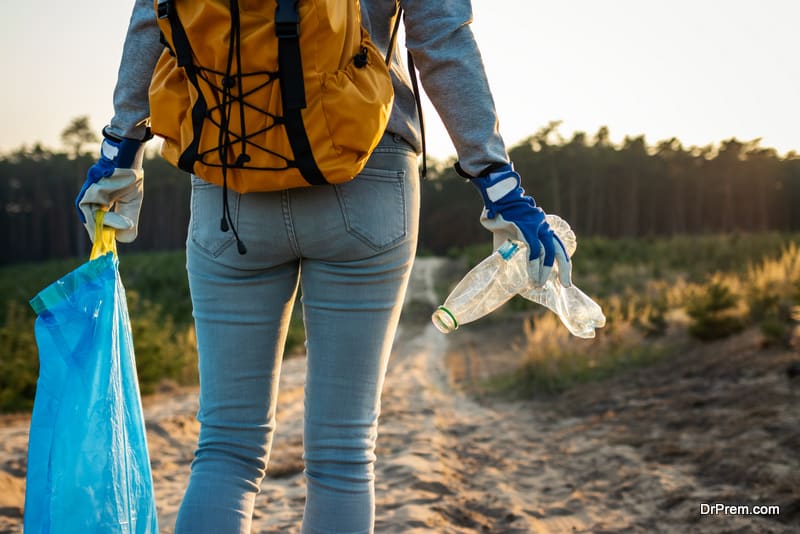
The best practices while on wildlife tourism ensure meeting a twin objective. The wild life and the habitat do not get harmed, and the tourist experiences a wonderful and hassle free trip.
While driving in your land rover along the wild life country, ensure that you keep your wheels on the track and do not go astray into the bush. You should drive carefully so that you do not run into an animal injuring or killing it especially while driving at night. Use headlights to make things before clearly visible.
Never honk loud to generate noise pollution scaring the animals away. Check on emission of large quantities of thick smoke, which generate carbon pollution. Care must be taken to ensure that the ecological balance of the jungle is not disturbed. Smoking and drinking on safari must be kept minimal.
Littering the forest with leftovers is to be avoided. Spilling of chemicals, oils and leaving behind plastic packets and non-biodegradable wastes could cause irreparable damage to the wild life and environment. Keep the size of the visiting group small. Bigger the size of the group, bigger will be the commotion and sound pollution which will scare the animals away.
When using camera, use the one with a zoom arrangement so that in order to take a better shot you need not be close to the animal and risk a contact. This may initiate a flow of disease from one to the other or provoke an attack. It is better not to use flash while taking snaps and bother the animals.
While approaching a wild animal try to be quite and still. Keep a safe distance from the animal you are watching. You must not stalk the animal with a sneaking stealthy gait to give it a feel from its animal instinct that you are a threat and mean harm.
Inside the forest, try to avoid the use of gadgets that generate electronic emission and waves. This is a silent killer particularly having an adverse impact on birds.In a wild life safari, keep your eyes open and your senses alert as there is a wonderful opportunity to learn a lot about animal habits and their behavioral pattern. While following the tracks, trails, droppings and spoors lots of information are revealed. You feel excitement rush up your blood stream.
The droppings not only indicate the contents of its diet, but its freshness is a clear indication of the time elapsed after the animal had passed the region and its present distance from you. All you need is a keen pair of trained eyes and a mind that can draw logical inference, and the rest is all excitement and fun.
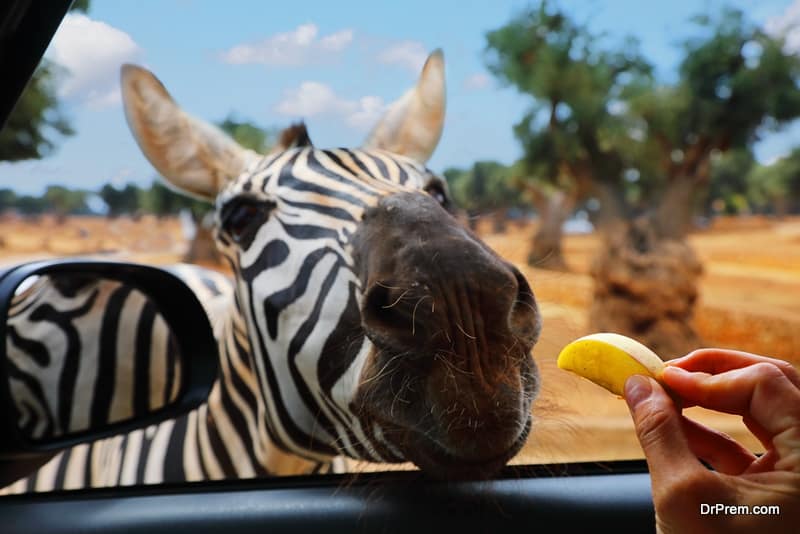
Hand feeding of animals in the wild and cuddling wild life cubs are strictly prohibited as it is an easy way for flow of diseases. Where feeding is approved, food should be nutritionally certified.
Studying animals intently with dedication gives you a lot of insight into wild life behavior. It is a great experience to explore the animals behave in a finely weaved society. Their communication patterns, vocalizations, sign languages and gestures indicate specific moods and group codes. It is simply wonderful and educative to be conversant with their system of communication and predict the way an animal will react to a specific environment.
Watching wildlife is fine and it would be a better practice if we mix a little deliberation so that they are not treated as mere objects of visual amusement. Their plight must be addressed with compassion and solutions provided highlighting the importance of conservation of the ecosystem.
Precaution and prevention tips in wildlife tourism

Preventive and precautionary measures won’t guarantee you a hazard free wild life expedition, but they minimize the chances of perils striking you in a jungle. The wild is always a home to a host of insects, which are the carriers of lethal diseases like sleeping sickness, malaria and yellow fever.
Anti malarial vaccines are of crucial importance in order to keep you safe from Malaria. If you are planning to camp out in a jungle, extra care is needed to make your tent fool proof against invasion of insects, leeches and snakes. Putting a mosquito net is a must while you sleep. Spray carbolic acid around your tent to keep snakes and venomous millipedes at bay.
Keep a stock of emergency medicines while on wild life safari. The nearest medical unit may be a two-day affair to reach when you need to rush to a hospital in an emergency. In a wild life country, these are the facilities you will crave for in times of need, but you won’t get one around.
When you select a tour guide in a jungle safari, make sure that he is vastly experienced and trustworthy. His credentials and past records are very important because the moment you leave your lodge for expedition, the guide is the man on whom you will have to depend most.
Equally important is the condition of the vehicle on which you ride throughout the expedition. If the vehicles break down in the middle of the trip, you are in a real tough situation. Condition of the vehicle is to be thoroughly checked before starting.
Stock of fuel is to be checked and its sufficiency ensured else the safari vehicle will stop midway. As vehicles ply over long distances in a wild life country where uncertainty is common, stock of dry food and drinking water are necessarily to be carried.
When you have chosen a specific reserve forest for a visit, get the information about the rainy season which you must certainly avoid. Do not smoke and dispose garbage in a safari park as this may land you behind the bars. Choose clothes with green, brown or light yellow shades to get you a camouflaging cover.
You will appear like a part of the forest. Brightly colored clothes often antagonize animals which might culminate in an attack. For similar reasons, wearing strong perfumes and body sprays are advised against. Always use a flash less camera, and a general alertness is a must in a safari park as you do not know a predator might be lurking behind a stand of bush. While in safari you may need to travel on foot covering a long distance. Knee length thick leather boots are advised as a guard against snake and insect bites.
Stepping into grassland in an African game reserve or in an Indian safari park are not exactly the same as taking a stroll across Kew Gardens or Hyde Park for that matter. Many a lethal animal and other life forms may be lying in wait ready to strike! So a word of caution would sound appropriate before such a venture.
Things to do post wild life tourism

Your expedition to the plant and animal kingdom does not come to an end with your trip to the jungle being over. It is just a beginning, a platform you have beneath your feet to launch a little effort to sustain the world of flora and fauna against rapid industrialization leading to a merciless destruction of wild life habitat. You plant a hundred seedlings for every plant life destroyed goes the statement.
It is a close-knit triangle where the plants, animals and human beings are so dependent on each other that destabilizing the ecological balance will affect us in a dangerous way. Wild life tourism has exposed us to a firsthand experience of watching animals in their habitat. They are graceful and a wonderful manifestation of power and speed.
Even if they are on a hunting prowl, they do it out of necessity to survive. There are no commercial schemes or mean and diabolic intents playing in their minds. Peace, family and group attachments, affection and a constant ruthless battle to survive through a day are the fundamentals on which their daily itinerary is drawn up. Wild life tourism is one such a constructive step to enable animals and human beings share the same planet and its resources and exist peacefully.
Wild life and their habitats are a perfect setting for furthering your knowledge in the subject. You need two resources your camera and your diary to pen your observations. A weaver bird working on building its nest is a fantastic study of nature. You observe the entire engineering skill, precision and patience with which the tiny piece of architecture comes up. Back home you can compose a write up and post a blog on the net with your photographic illustrations, a fitting tribute to the architect.
The same excitement can be achieved and spread through the internet regarding the group behavior of lions when stalking a mixed herd of wildebeests and zebras. The feeding frenzy after a successful hunt is an action worth putting on the net for the world to see.
Opinions, blogs and descriptions with illustrations are needed to be put online to bring in a larger section of tourists under wildlife tourism. The trips to the jungle do not harm the plant and animal life. It is an expedition wonderfully designed to achieve joy ensuring safety and ecological balance of the habitat.
The spirit of wild life tourism is directed at a bigger objective of sustaining plant and animal kingdom encompassing all kinds of habitats. The oceans and rivers can be explored to take pleasure from watching marine flora and fauna. No oil slick or grease strain is to be left in water, and tourists are to be made conscious of the consequences through media.
The sky and mountains, deserts and cold icy plains, forests and grasslands are practically crawling with wildlife. Photographs of this immense wealth can be taken and communicated for drawing tourist awareness to make them realize the existence of another world beyond the fringes of the concrete jungle, and also to ensure that this beautiful world does not shrink to a non-existing entity under the assault of modernization.
Post wild life tourism you can design a compact module for your next visit if you are dying to visit a dream destination in the future. You are now well experienced in wildlife tourism. You were exposed to wild nature and you know the limitations. The lessons learned from the first trip will make you better prepared for your next venture. These are the exercises you need to do post wildlife tourism so that your next expedition turns better than the first one.
Countries promoting wild life tourism
Many countries have realized their rich diversity of plant and animal life can be a source of tourist entertainment. This natural wealth is a big support promoting the country’s economy. Many countries like Nepal, Thailand, Malaysia, India and African countries have been showcasing their wild life wealth to draw a huge number of tourists.
Nepal
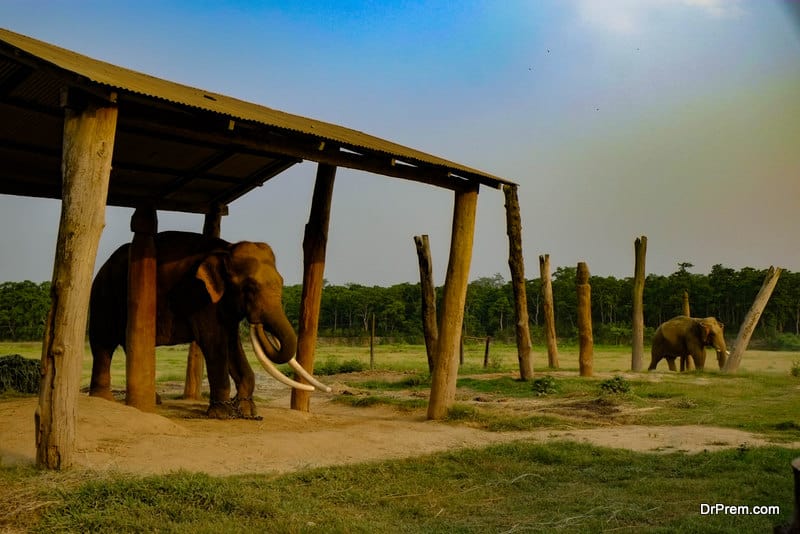
Nepal, a country sandwiched between India and Tibet is located in the foothills of Himalayas. The dense Terai forest covers a substantial land area. Chitwan National park is a home to elephants, tigers, Indian rhinos, leopards, monkeys and a host of birds. To promote tourism and for health care of elephants, polo is organized ensuring inflow of money. This money is used for launching remedies to combat diseases that affect elephants and for general upkeep of flora and fauna. Elephant rides are organized deep into the forest for rhino sightings.
Malaysia
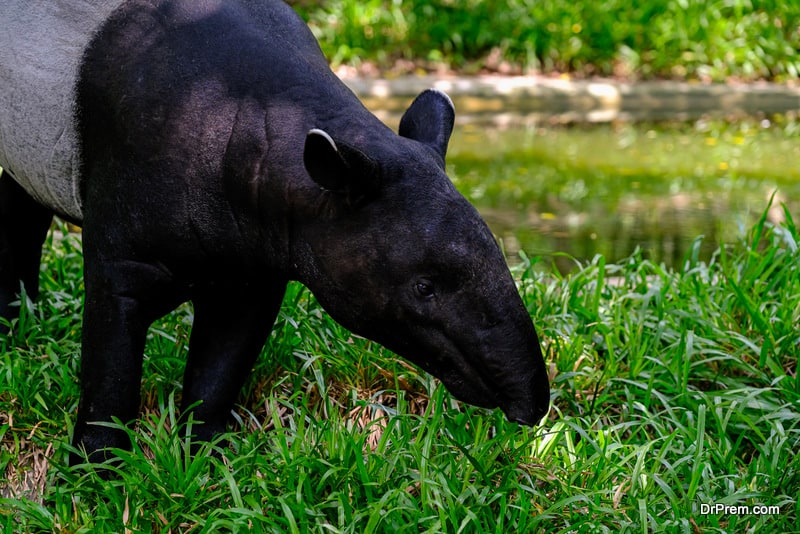
Malaysia has recognized the huge potential that rests in zoos. The country has targeted zoos as an inspiring media to promote wild life tourism. It is the kids who are seen flocking around animal enclosures in the week ends with their parents. It is a source of a big time pleasure, and the next thing they want to experience is to see the animals exactly the way they behave in their natural habitats. This unique idea of the government has received encouraging support from all corners and it is an innovative step towards making wild life tourism popular.
The orangutan the second largest primate has always fascinated man for their resemblance with him. Malaysian rainforest is where this huge acrobatic ape can be seen moving among towering woods. Quizzes on Orangutan and other animals are organized to arouse a keen interest in wild life and the flora among tourists that will lead to repeated expeditions to the Malaysian plant and animal kingdom.
Thailand
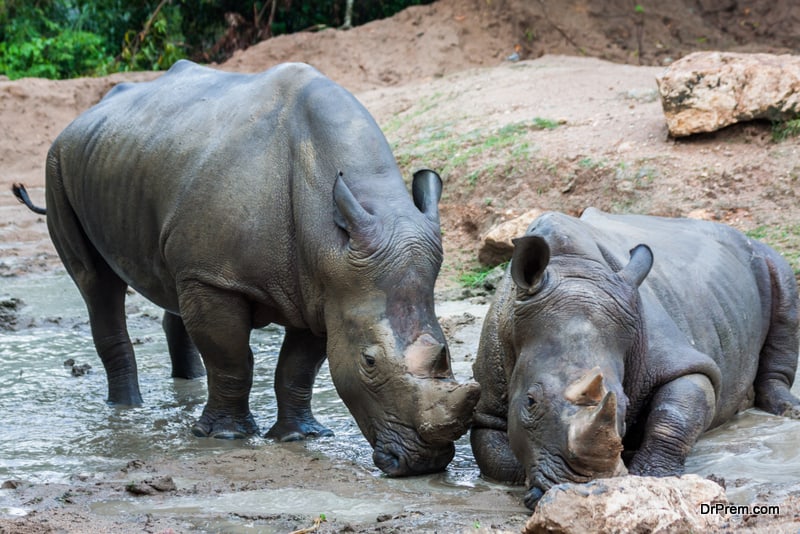
Thailand is rich in biodiversity and inspires wildlife tourism as a means to promote economic welfare. The country holds elephant polo competitions to promote wild life tourism. It is quite popular and draws a big crowd. Thailand has a wealth of exquisite wild life parks and sanctuaries and a huge attraction for animal and bird watching.
The forests abound in tigers, leopards, elephants, gibbons, wild pigs, barking deer, tapir, Sumatran rhinos, king cobras, deadly pythons and a large species of birds. Rafting, kayaking, waterfall trekking are featured adventure sports to spice up the spirit of wild life tourism.
India
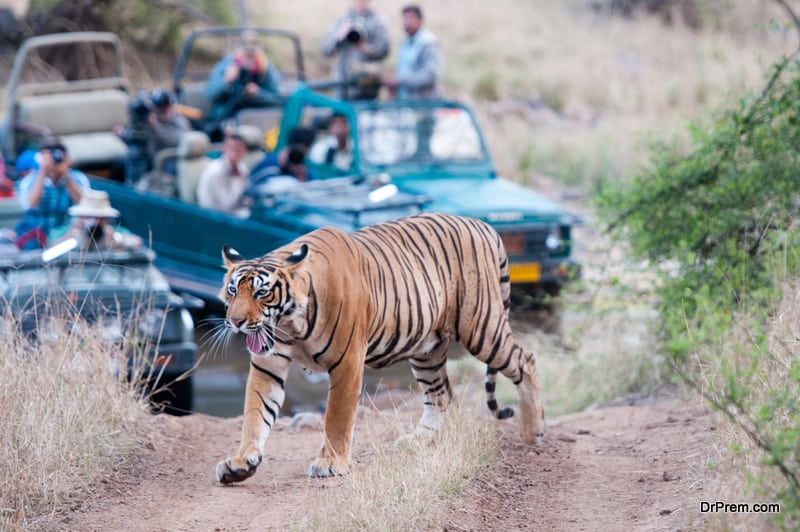
India with its enormous wealth and variety of flora and fauna has developed an effective and tourist friendly infrastructure to enable wildlife enthusiasts across the world to explore India’s forests. There are sanctuaries and reserve forests to follow the tiger trail like Manas , Bandhabhgarh, Kanha ,Namdapha and Sunderbans. Namdapha is famous for all the four species of the feline family -tiger, leopard, clouded and snow leopard roaming in altitudes ranging from 500 to 5000 meters.
The forest bungalows are cozy answering the needs of a tourist. Sunder bans which is a delta thick with mangrove swamps is home to one of the most ferocious breeds of tiger. The forest can be traversed only on steamers that sail across tributaries that cut through the region. The arrangements in steamers and forest lodges are reasonably good. In India, elephant rides are arranged in some reserve forests like Kaziranga and Manas to inspire tiger and rhino sightings at close quarters.
Kenya
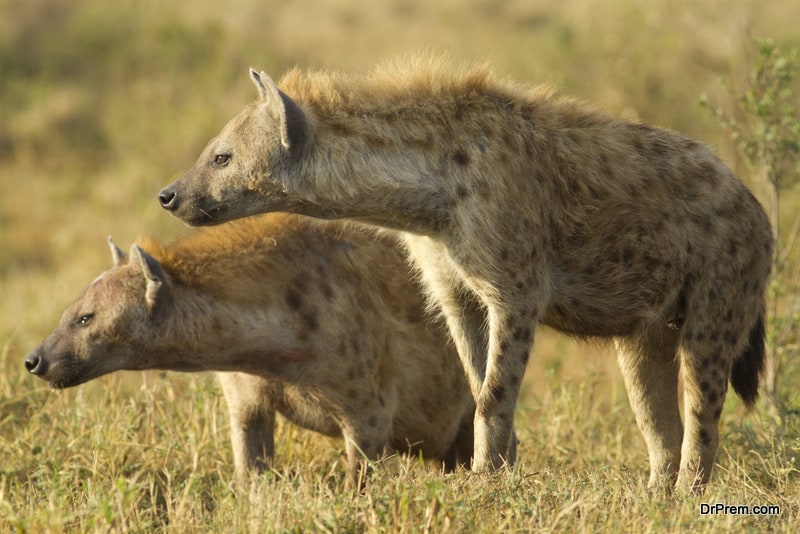
Reputation of Kenya as a big game country is fairly historical .More than 40 national parks and reserve forests are thick with wildlife consisting of lions, leopards, cheetahs ,elephants, hyenas, wild dogs, zebras and gnus to name a few. Its terrain is mottled forming a major tourist attraction. Wild life tourism and Kenya are inseparable and is a touch of delightful experience. Kenyan wild life is popular worldwide and the government is making every effort to expand its recognition further.
Eminent big game hunter like Roosevelt has a major say in upholding Kenya as an important wild life destination. Safari vans carrying tourists run over long distances and exclusive safari lodges exist offering tourists a hassle free stay. These are signals strong enough to put Kenya as a blazing destination in the global map of wild life tourism. The country is doing best to accommodate the influx of tourists pouring in from all corners of the world.
Boutique lodges are coming up fast to provide guests a luxurious stay amid tranquility and wilderness. To enhance the appeal of the atmosphere, Kenyan coastline is not far off with blue waves breaking against a long stretch of soft and white sands. The legendary region of Tsavo has a very strong tourist appeal for its association with a pair of ill famed man-eating lions who terrorized the country with their assaults bathed in human blood. Simba hills and Tatia hills are other destinations offering a first grade genuine flavor of wild life tourism.
South Africa
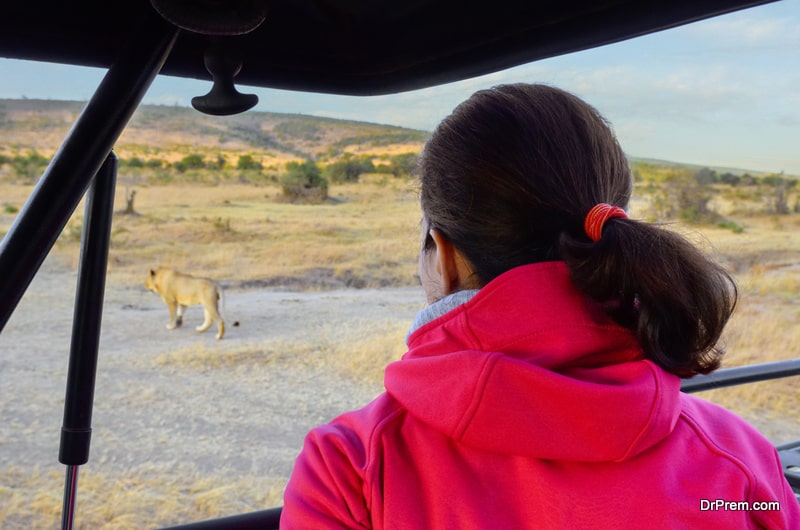
South Africa ranks third in the world in terms of bio diversity. It has become one of the world’s most prized wild life tourism destinations in the world and to support its tourist inflow, world class infrastructure has been set up and operated with utmost efficiency and class.
Besides its celebrated national parks, South Africa boasts of a range of private reserves all presenting brilliant wildlife and ornithological expeditions. To achieve distinct game exposure, the lower region of the Veldt of Limpopo, Mpumalanga and Kwazulu Natal province are the ultimate destination. Lazy lions stretch out in the sun after a hectic chase hunt experience the night before.
Herds of elephants clump elegantly through the bush with occasional trumpets sending deep chords around. There is a tour grading council whose function is to appraise the quality of safari lodges and grading is done compelling the lodge authority to improve on the quality of accommodation and service, a constant endeavor to promote wild life tourism.
Brazil
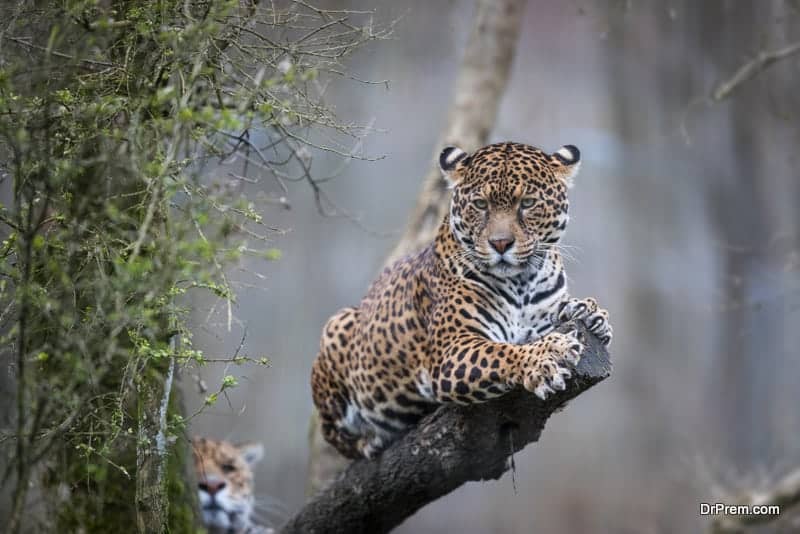
Brazil is blessed with a rich distribution of flora and fauna. The thick forest along the Amazon basin brings forth romantic undertones. It is a home to a host of birds, mammals and reptiles. To promote wild life tourism, fun cruises are organized offering good food and accommodation in steamers. The tourist watches the forest covered river banks for sighting jaguars, the iconic big cat of Amazon on prowl.
The rivers house caimans, and if you are lucky a caiman-anaconda fight would give you waves of kick. The forest comes alive with shrieks and shrills of monkeys, birds, capybaras and a swarm of insects. Guided tours are organized mostly on cruise drawing wild life buffs from around the world. Some of the world’s most primitive tribes inhabit the jungles and sure is a wonderful experience meeting them.
Wildlife destinations for greatest experience on the planet
There’s something really exhilarating about watching wild animals in their natural habitats rather than behind cages in zoos. And when it comes to some of the greatest wildlife experiences on the planet, these destinations literally take the cake. Given below are some of the best wildlife destinations in the entire world.
Uganda
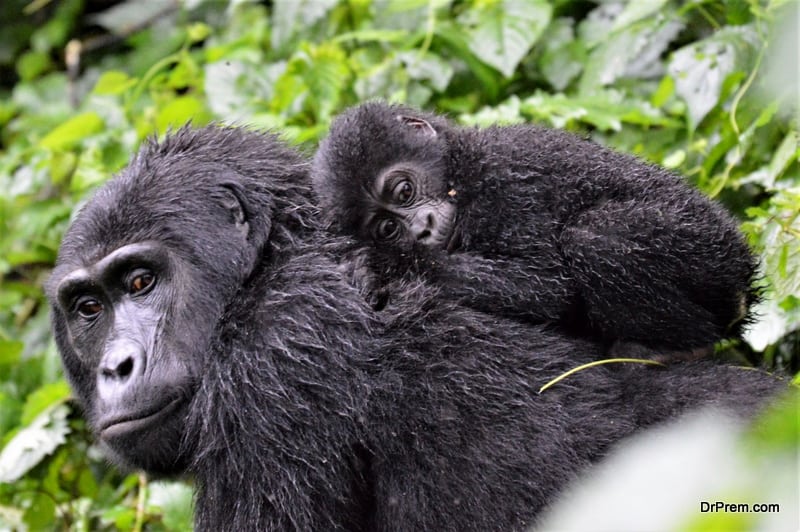
If there’s one thing Uganda is famous for, it’s the numerous gorilla habitats situated around the country. Watching gorillas can be exciting and daunting (you never know when they would charge at you). And the wildlife safaris in Uganda would let you get as close as possible to these gigantic creatures. The moment you get close, you would actually be amazed by the gentleness of these creatures who only charge when they feel intimidated or threatened. The safaris also cover different species of these animals and let you catch glimpses of lowland gorillas as well as mountain gorillas in the Bwindi forest and the Virunga Mountains respectively.
Vancouver
Vancouver happens to be one of the premier destinations in the world for whale watching. Thousands of visitors flock to the island every year to watch the annual migration of these massive marine mammals. You can watch all kinds of whales like humpbacks or orcas from lookout points on the shores, or opt for boat cruises that would let you drift along with the whales as they move seamlessly through the water, surfacing now and then in between to breathe. It’s truly a spectacle to watch these animals, and you would be ensured plenty of memorable photos by the end of your trip.
Galapagos Islands
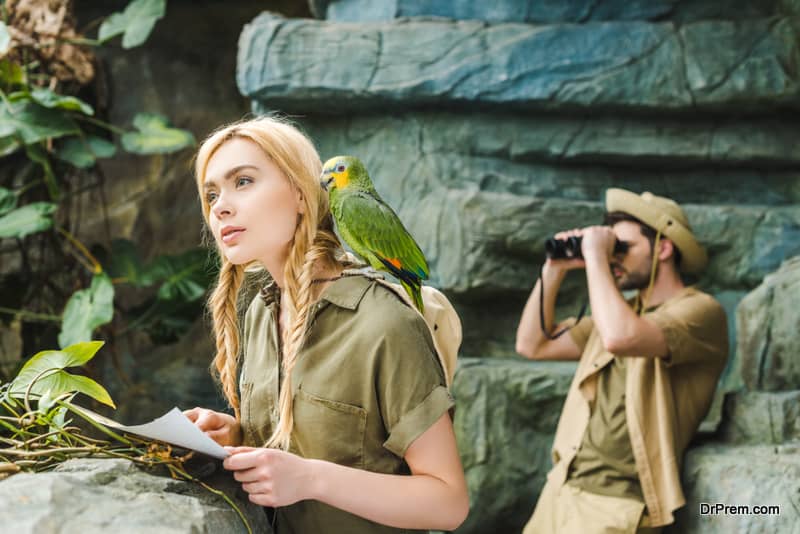
Bird lovers would surely add the Galapagos Islands to their list of must visit adventure destinations. Considered to be the one of the premier ecologically diverse regions on earth, the islands are hotspots for animals, birds and marine creatures that stop over here for a quick break before resuming their journey. You can easily spot several exotic creatures that can never be found anywhere else on the planet. And you will definitely be sorry if you forgot to take a camera along with you.
The Arctic
Not really a continent, the Arctic is a single piece of solid ice that just floats around without a base. And if you want to catch glimpses of some really cuddly (just kidding) polar bears, you can head over to this region.
Polar bears are recently gaining media attention due to the effects of global warming on their life span and natural habitat. A cruise through the Arctic would let you catch glimpses of quite a few of these giant creatures as they laze around on the ice or hunt around for food. If you are lucky, you can also catch glimpses of seals, walruses and penguins.
Borneo
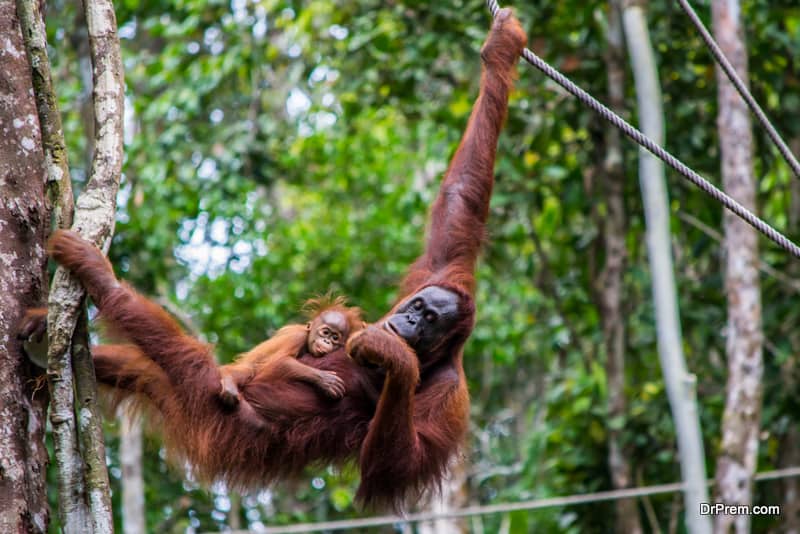
Borneo in Malaysia is said to house the highest population of endangered orangutans in the world. Extremely gently and cooperative, these animals are literally darlings, and don’t mind being visited by a few tourists now and then. Sadly, environmental factors like deforestation have left them with very few places they can call home.
A trip to Borneo would enable you to meet and interact with these furry creatures. You can also visit the Sepilok Orangutan Rehabilitation Center that specializes in rescuing trapped or injured orangutans, nursing them back to health and then releasing them into the wild after they regain their health. And while you are at it, you can opt to see other animals like hornbills, proboscis monkeys, gibbons and pygmy elephants that have made the region their home.
Sipadan
Located quite close to the island of Borneo in Malaysia, is another island called Sipadan which is known far and wide for its massive turtle colonies. A snorkeling excursion in this region would actually let you snorkel along with endangered hawksbill and green turtles.
The stunning beach of the island gives way to a massive reef wall that reaches depths of 600 meters. And in addition to snorkeling with at least 30 of these gentle creatures at the same time, you can opt for scuba diving excursions that would take you deeper into the ocean to spot a variety of other amazing marine creatures in their natural habitats.
Super enjoyable wildlife safari destinations from around the world
The African continent is home to some if not all of the most important safari destinations and game reserves in the entire world. Every year, millions of tourists flock to the continent in favor of its wildlife safaris that would help them get as close to the Big Five as they possibly can. So without further ado, here are the top safari destinations in the world that you definitely need to visit if you are a wildlife enthusiast.
Kenya – Masai Mara National Reserve

Considered to be Africa’s most popular safari destination, the Masai Mara Reserve in Kenya is famous for its wildebeest and zebra migration that takes place between the months of July-October. Tours will take you as close to the herds as possible so that you can get a fantastic view of the migration that involves millions of these animals.
South Africa – Kruger National Park
Your chances to see the Big Five in action would increase manifold if you opt to visit the Kruger National Park in South Africa. Boasting of housing the most diverse range of wildlife species on the planet, the park also offers you the unique experience of opting for a self-driven safari and is very well maintained.
Botswana – Chobe National Park
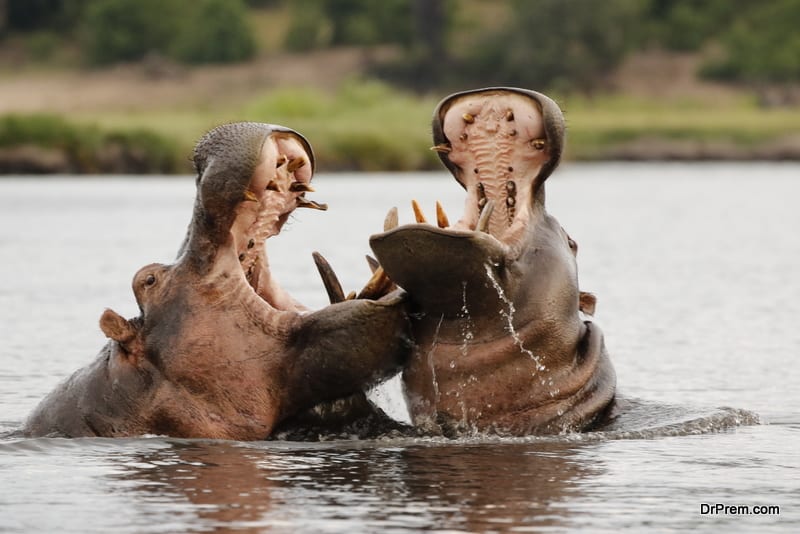
The highlight of the Chobe National Park in Bostwana is that the part covers four different eco-systems, meaning it has one of the highest concentrations and most diverse range of wildlife in the continent. Another highlight of the park is the sheer number of elephants you can find here (over 120,000). Along with this, you can spot herds of buffalos, zebras, wildebeests and giraffe crossing the Savuti marsh between April and October.
Uganda – Bwindi Impenetrable Forest Reserve
A trekking tour of this amazing forest reserve would get you the chance to enjoy very close encounters with menacing looking but gentle mountain gorillas. You can find over half of the world’s gorilla population in the reserve, which is also home to a diverse range of bird species. The trekking tours would also take you past jagged valleys, misty waterfalls and dormant volcanoes. So don’t miss this one out.
Namibia – Etosha National Park
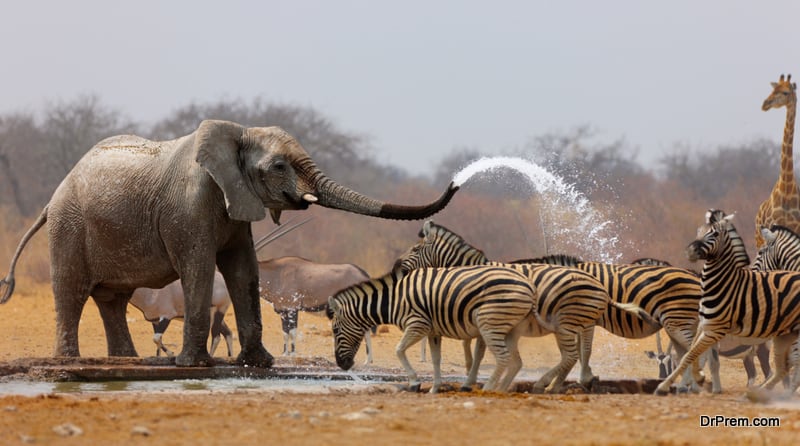
Make it a point to visit the Etosha National Park in Namibia to see the tallest African elephants in their natural habitat. In addition to enjoying wonderful views of these majestic animals, you can also catch glimpses of over 91 species of animals, including the endangered black rhino. Try to plan your visit during the dry season as this would be the time all the animals in the park start visiting the waterholes, offering you plenty of photographic moments. You can also opt for a self-drive safari, which would let you enjoy close views of animals like giraffes, lions, elephants, rhinos, leopards and cheetahs.
Tanzania – Serengeti National Park
Visit the Serengeti National Park in Tanzania if you want to enjoy a firsthand experience of a classic African wildlife safari. The area is world famous for the annual migration of millions of zebras and wildebeest making across the plains in gigantic herds. What’s best about the Serengeti is that it is mostly grassland, therefore giving you fantastic views of the migration as well as the lion kills that occur frequently in between.
Zimbabwe – Hwange National Park
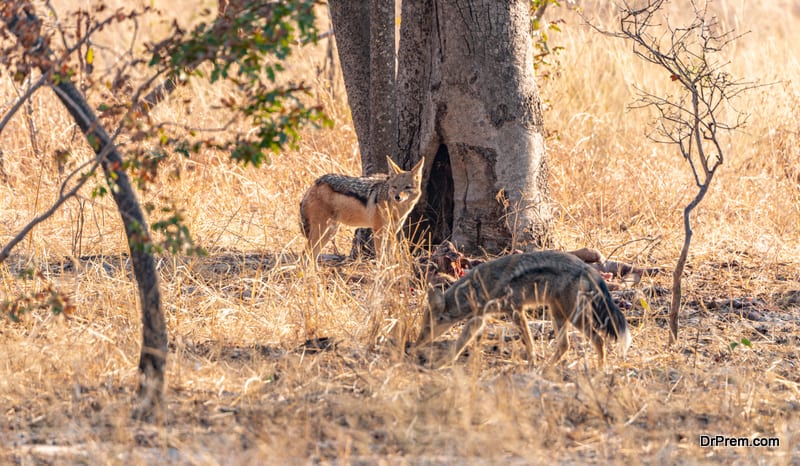
Home to over 105 different kinds of animals, including elephants, lions and giraffes, the Hwange National Park is a must visit for those who love wild dogs. The park houses one of the highest wild dog populations in entire Africa. Better yet, it is located quite close to the stunning Victoria Falls as well as the electrifying Devil’s Pool.
Wildlife tourism near the Congo River
Wildlife tourism is a part of tourism, which provides an opportunity to animal lovers to spend some time in the natural environment and explore different animals. When we talk about Africa then it is the most popular wildlife tourism destination. Congo River is an African River and its basin makes up one of the most important wilderness areas left on the Earth. It is the second largest tropical forest in the world.
The forest located near the river basin houses various birds, animals, and reptiles. It is one of the best places to visit and enjoy your holidays in the natural and soothing environment. Visitors can explore the small villages of the region and can understand the tradition, history, and culture of the region.
National parks
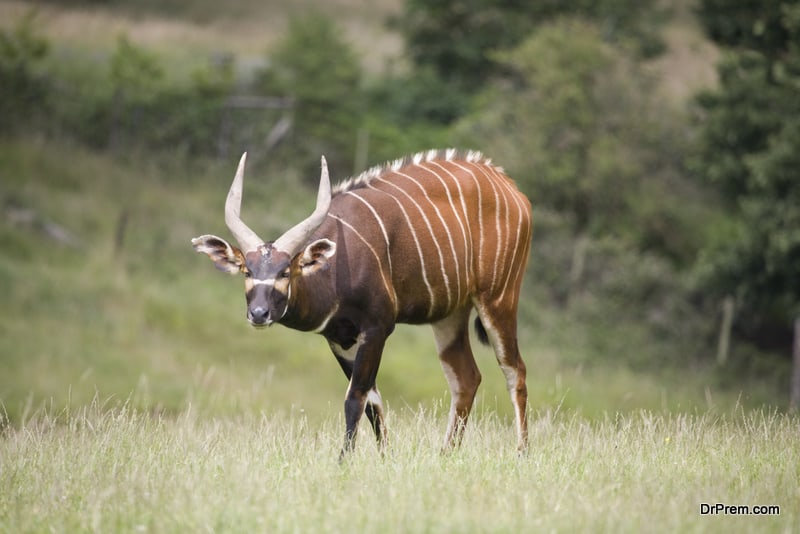
The region houses many wildlife reserves and national parks. It provides visitors an opportunity to explore the wilderness of the region. They can visit to national parks, which are located on and near the banks of river Congo. This includes Nouabale-Ndoki National Park and Dzanga-Ndoki National Park.
Nouabale-Ndoki National Park
It is a beautiful national park located in the Republic of the Congo. It was established in 1993 and known for its elephants, apes, gorillas, chimpanzees, and bongos. Nouabale-Ndoki National Park is spread over 3,921.61 sq. km and houses the tropical rainforest. The minimal human habitation in the region makes it a perfect place for wild animals. The forests have a rich biodiversity as it houses about 300 bird species, more than 1000 plant species, and provide protection to various endangered plant and animal species.
Many providers run safaris for tourists in the park. This is also an effort to make people aware about the wildlife conservation. Visitors can gather authentic travel information from the official tourism site of the country. The information includes everything about best time to visit the destination, tourism facility providers, lodging facilities, and travel packages.
Dzanga-Ndoki National Park
Dzanga-Ndoki National Park is another popular park located in the south-west of the Central African Republic. This beautiful national park was established in 1990 and covers an area about 1,143.26 sq. km. It is also an amazing wildlife tourism destination, which offers an opportunity to wildlife and nature lovers to explore the destination. They can spot animals like African forest elephants, red river hog, endangered Bongo, giant forest hog, and African forest buffalo.
Apart from this, it is an idle place for hiking, camping, and river rafting. Visitors can enjoy their vacations in the majestic and natural location.
Bird’s Paradise
This forest is a paradise for birds as visitors can spot migrated birds and various endangered bird species. The region houses more than 1130 species of birds, which is comparatively more than any other country in the continent. It is a home to wide variety of birds, including water birds, birds of prey, ground birds, fruit eaters, hole-nesters, and passerines. Lucky tourists can spot perching birds, which include endemic species only found in this forest and the part of the world.
Various tourism service providers offer different tour packages to this part of the world. Visitors can make their lodging arrangements and travel arrangements from their home. They can explore the natural beauty of the place and can go for different safaris and special guided tours. They can also visit the villages and know more about the rural and wild Congo.
A guide to finding budget wildlife holidays
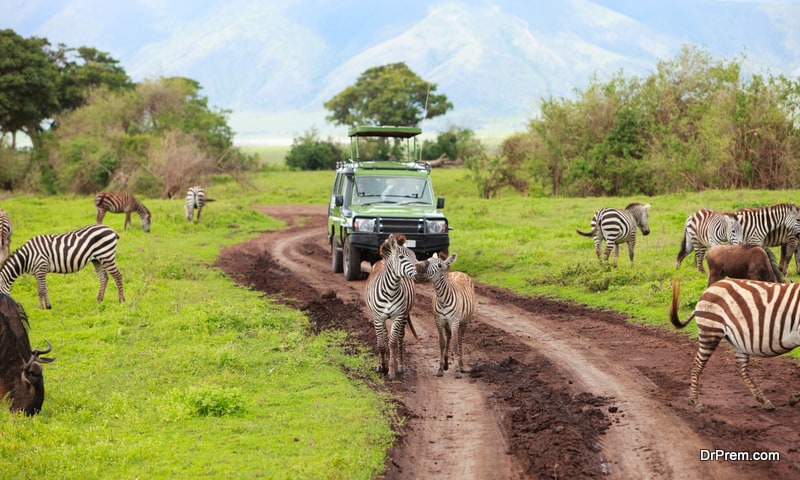
Passionate about wildlife holidays but want to avoid crazy spending? Why not go for budget wildlife holidays? It may be attractive package deals offered by tourism companies or a great self-planned itinerary. Any option you choose, it is always recommended to check your resources and be well informed. Preparedness is one thing you need to ensure in order to enjoy a great wildlife trip.
Follow the stepwise guidance to know more about cheap safari holidays, the requirements and other vital information.
Steps to planning budget wildlife holidays:
Destination selection:

Which part of the world you would like to visit? Which species attract you most? Are you a conventional vacationer or look for something exceptional? Your destination choice and vacation planning will be based on these.
Put your best online-searching efforts. Google is a great assistant. Also, check mammalwatching.com that provides an extensive overview of trips with loads of info about animal species and their spotting sites.
Google Earth and observado.org are other helpful tools to help you plan different categories of budget wildlife holidays. Facebook groups and forums are great for information gathering where you will get ample suggestions of the most affordable wildlife packages.
Package deals or DIY holidays?
The choice is entirely yours. Package holidays often carry few benefits. They give you full cover, save your time and enable best savings in budget wildlife holidays especially for 7, 10 and 14-day vacations.
While for shorter durations, DIY holidays will be more suitable. You will have the flexibility to make your choice. While looking for package holidays:
- Check the comparison sites, tour operators and flash deals for best price.
- Offbeat wildlife spots can give you better deals.
- Make a list of popular tour operators offering budget wildlife holidays.
- Talk to the tour operator directly to check out the best time and best price fitting your budget.
Accommodation, when to go and other traveling issues:
Transport:
You can avail discounted airfares if you are a bit flexible on travel dates. You can find some attractive deals on Skyscanner.com. Consider traveling by bus or train if airfares are hard to beat.
Accommodation:

Accommodation costs eat up a large fraction of your travel budget. You can consider the following cost-saving accommodation options:
- Hospitality exchange: You can avail free accommodation if you can stay with a local. He may provide you a free place to rest and valuable info about wildlife behavior.
- Hostels: Usual budget accommodation is meant for all ages and do not necessarily imply sleeping in dorms. Single and double rooms for solo travelers and couples are available. Amenities are even more than average hotels. Check with the Hostelworld site to choose from a great inventory.
- Home Exchange: Mostly suitable for travelers owing a home. For a scheduled period, you can swap homes with the family while traveling to another country/destination. No extra accommodation expenses. It is feasible only with like-minded persons as both sides should be willing for this exchange. Check the sites Home Exchange, Seniors Home Exchange, Home for Exchange or IHEN for a better idea.
- House Sitting: Here you take care of the house when the owners are away for a vacation. At the same time, you enjoy your wildlife vacation too. House sitting schedule normally runs for weeks or a month. Few sites to help you are Mind My House, House Carers and Luxury House Sitting.
- Airbnb: Needless to mention this has been the most popular option in budget wildlife holidays. You get to stay in well-furnished apartments but pay much less than hotels. All amenities are available and you enjoy home comfort.
- Farm Stay: One of the most affordable staying options in budget wildlife holidays. Exposure to running a farm is an added bonus to your wildlife experience. Facilities range from basic standards to luxurious accommodations. Within $40/night, you can expect a decent stay. Resourceful sites are: Farm Stay UK, Farm Stay US, Farm Stay Australia.
Top budget wildlife holidays for a lifetime experience:
Talking of wildlife holidays, the first name that strikes our mind is Africa. Few budget packages listed below will help you get an idea of the budget wildlife holiday packages normally available. The duration, price and terms and conditions will vary depending on the tour operator.
Note: Cost may vary depending on the fluctuating market prices and demand.
Cheap safari holidays in South Africa:
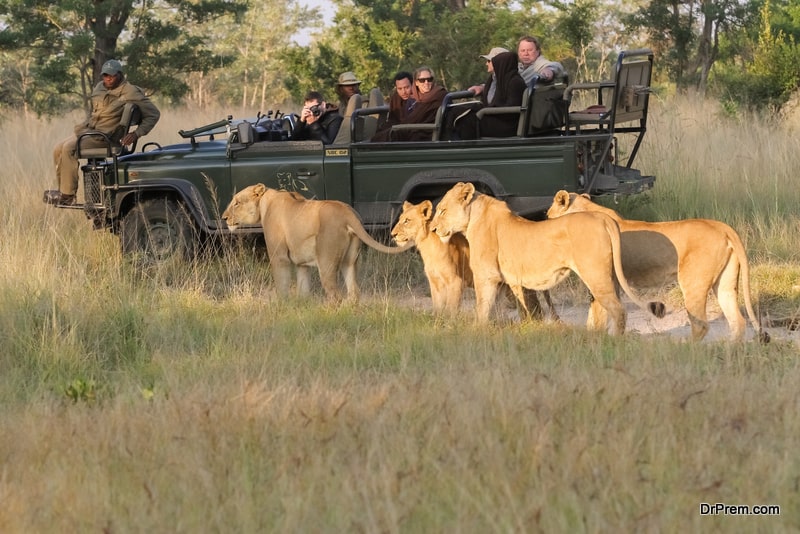
Duration: 2 days
Cost: Below $1500
One of the greatest opportunities for wildlife exploration on a budget you get in South Africa. This 2-day action-packed safari not only helps in savings, but also ideal for those looking for short trips. While you go through bush walks, wildlife tracking, game drives, enjoy the fascinating experience of spotting wildlife icons like lions, elephants, giraffes, buffaloes and more.
Masai Mara Safari, Kenya:
Duration: 3 days
Cost: $330/per person including transport cost from Nairobi, 2-night full-board accommodation and parking fees for 4 game drives.
Another cheap safari holiday that most wildlife lovers would be looking forward to. You may have to give up some comfort owing to 5-6 hour road travel from Nairobi; but spending nearly 2 full days observing the wildlife giants and the great wildebeest migration of Serengeti is an experience of a lifetime.
Gorilla Safari, Uganda:
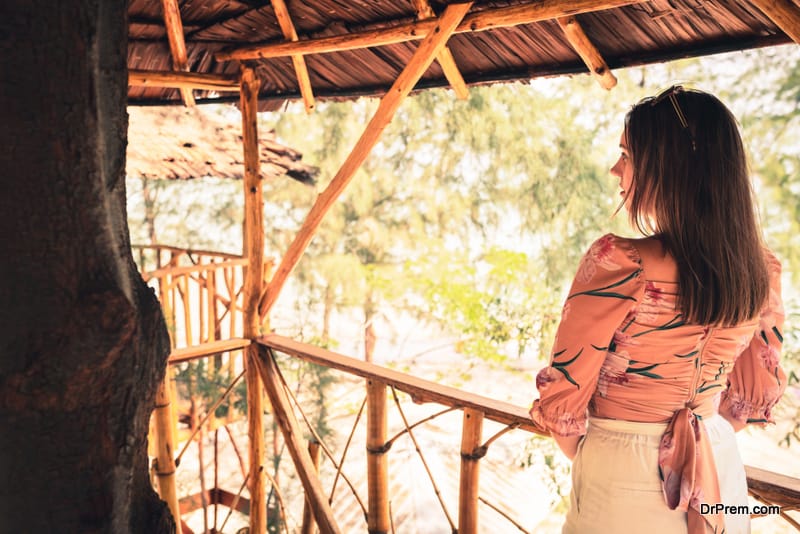
Duration: 3 days
Cost: $895 per person including road transport from Kampala, 2-night full board accommodation, a day for gorilla tracking and its permit.
Gorilla safaris normally are painfully expensive. This budget package is possible for the discounts offered by the Ugandan Wildlife Authority during lean season from April-May and November. You get to stay in a lodge overlooking the picturesque Lake Mutanda and Virunga Mountains. You track gorillas through the dense Bwindi Forest and spend an hour with them.
Rhino tracking and Nile cruise, Uganda:
Duration: 3 days
Cost: $380 per person. Include 2-night accommodation in shared tents, to and fro transport from Kampala.
Another cheap wildlife safari that heads to the Murchison Falls Park – the largest in the country. Enjoy a picnic overlooking the spectacular falls and spend a night at the base camp in the upper Nile. A thrilling game drive at the Nile delta at Lake Albert awaits you where you may view lions, giraffes, elephants and leopards. Next day, move on to the Ziwa Rhino sanctuary to track rhinos with the help of forest rangers.
Serengeti and Ngorongoro crater, Tanzania:

Duration: 4 days
Cost: $1217 per person. Include transportation from Arusha, 3-night full accommodation in campsites, camping gears, game drives and fees of parks.
Serengeti safari is in the wish-list of many travelers. It may cost a bit high than other packages offered in budget wildlife holidays. But the experience is worth it. The expansive woodlands are the home to some of the incredible wildlife species.
You get the marvelous experience of wildebeast migration when nearly 2 million animals start crossing the Mara River. Expect some spectacular wildlife activities when you stop the can and watch dumbfounded. The floor of the long-extinct Ngorongoro crater shelters herds of animals worth viewing.
Johannesburg and Kruger National Park:
Duration: 7 days (you can make it less)
Cost: $929 per person. Include walking tour, Kruger safari, drive to sunset, morning safaris, trained guides, food and accommodation.
Wildlife lovers will not like to miss out the world-famous Kruger National Park Safari. Tour operators offer all-inclusive packages, including pick up and drop facilities. A walking tour in Johannesburg will be an added attraction. Kruger park safari exposes you to a new world of wildlife and landscapes. It is great to watch lazing lions, tall and elegant giraffes, enormous elephants and jumping wildebeest.
Budget wildlife holidays from around the world:
Let us have a look at a few different types of wildlife holidays:
Kayak expedition in San Juan:
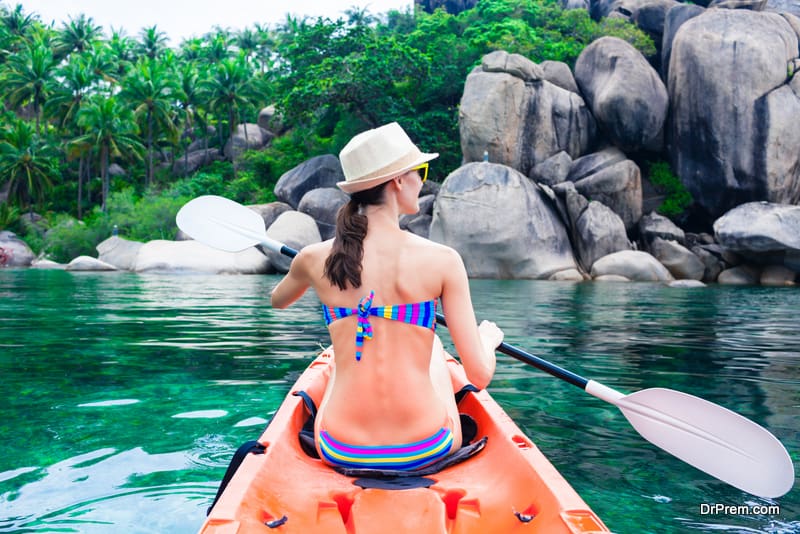
Duration: 5 day
Cost: $850 per person. Include kayaks, tents, breakfast, dinner, guides, cooking gear etc.
While paddling kayaks relaxingly around San Juan Islands, you spot an orca at a distance. Imagine the thrill! Not only this. A group of sea lions will pass your kayak playfully. This 5-day trip assures varied types of adventure packed wildlife encounters. Stunning views of hidden beaches and other marine wildlife sighting is a bonus attraction.
Explore turquoise waters of Maldives:
Duration: 8 days
Cost: Below $1500
You can opt for this budget-friendly destination to explore the jaw-dropping wildlife and landscape. Male, the capital city, is worth exploring. Move towards the tropical islands of Guraidhoo and Maafushi for mind-blowing snorkeling expeditions. The colorful underwater marine fauna will leave you stunned.
Participate in turtle conservation, Guatemala:
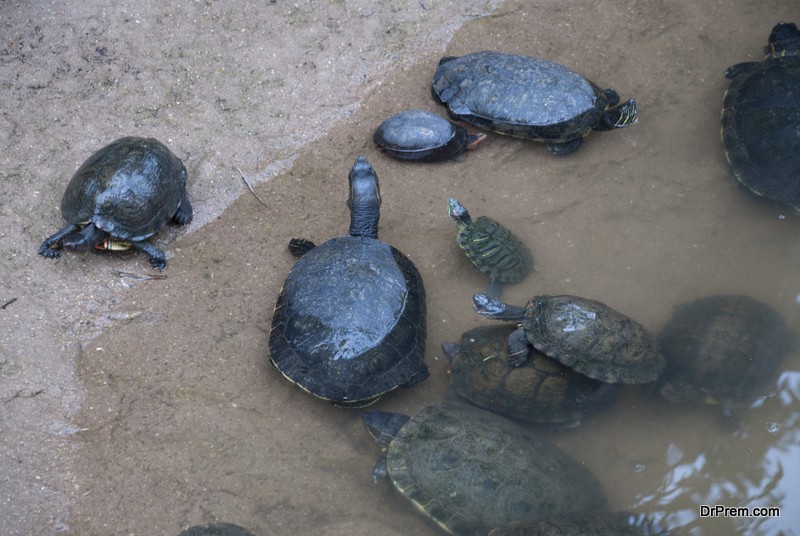
Duration: 1 week
Cost: Below $1500
Being a passionate wildlife lover, you can devote few days in turtle conservation to prevent them from extinction. Volunteering in sea turtle conservation is a fulfilling experience as you get an opportunity to contribute something to nature. Participate in beach patrols, beach cleanup programs, hatching process and releasing them in water. You explore the local areas and towns, mix with people and enjoy their culture and cuisine.
Volunteering wildlife rescue, Costa Rica:
Duration: Minimum 1 week
Cost: Registration fee $608 per person (1 week) or $878 per person for 2 weeks. An all-inclusive package including food, transport and accommodation.
It is an off-the-track budget wildlife holiday where you volunteer for care and rehabilitation of Costa Rican fauna. The country is the home to a myriad wildlife species. The objective of the rescue center is to protect and shelter animals that are victims of poaching, deforestation and illegal trafficking. Your contribution can make a huge difference in their lives.


